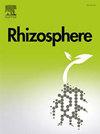酸性堆肥茶降低了石灰性棉田真菌多样性,但改善了群落结构和磷有效性
IF 3.4
3区 生物学
Q1 PLANT SCIENCES
引用次数: 0
摘要
酸性堆肥茶(CT)可为钙质(碱性)土壤中的棉花提供养分,改善土壤性质;然而,真菌对根际营养条件和理化性质的响应尚不清楚。研究了棉花根际土壤磷形态和真菌群落结构与功能对CT的响应。结果表明,CT处理显著提高了棉花根际土壤中水分磷、NaHCO3-P和NaOH-P含量以及棉花对养分的吸收和积累。根际真菌多样性下降;然而,该物种形成了一个更复杂和稳定的群落。此外,担子菌等低营养物种的相对丰度也有所下降。随机森林分布和Mantel试验表明,土壤pH和不稳定磷(水磷和NaHCO3-P)和中等不稳定磷(NaOH-P和HCl-P)比例的增加是真菌种类组成变化的主要驱动因素,这直接影响了不同营养模式下真菌种类的丰度。结构方程模型表明,磷有效度的提高是棉花干物质积累和产量增加的主要因素。本研究揭示了高温胁迫下根际土壤磷形态和真菌群落的变化及其影响因素,探讨了钙质土壤磷的有效利用与根际真菌微生态的关系。本文章由计算机程序翻译,如有差异,请以英文原文为准。
Acidic compost tea reduces fungal diversity but improves community structure and P availability in calcareous cotton fields
Acidic compost tea (CT) can provide nutrients for cotton in calcareous (alkaline) soil and improve soil properties; however, the responses of fungi to rhizosphere nutrient conditions and physicochemical properties remain unclear. In this study, the responses of phosphorus (P) morphology and fungal community structure and function to CT in cotton rhizosphere soil were examined. The results indicated that the contents of water P, NaHCO3-P, and NaOH-P in rhizosphere soil as well as the absorption and accumulation of nutrients by cotton were significantly increased following CT application. The diversity of rhizosphere fungi decreased; however, the species formed a more complex and stable community. Moreover, the relative abundance of oligotrophic species, such as Basidiomycota, decreased. Random forest distribution and Mantel tests revealed that the main driving factors in the compositional change of the fungal species were soil pH and the increasing proportion of labile P (water P and NaHCO3-P) and moderately labile P (NaOH-P and HCl-P), which directly affected the abundance of species with varying nutrient modes. A structural equation model revealed that the primary factor for dry matter accumulation and yield increase in cotton was increased P availability. This study revealed the changes in P morphology and fungal community in rhizosphere soil in response to CT and factors contributing to these changes as well as evaluated the relationship between efficient utilization of P in calcareous soil and rhizosphere fungal microecology.
求助全文
通过发布文献求助,成功后即可免费获取论文全文。
去求助
来源期刊

Rhizosphere
Agricultural and Biological Sciences-Agronomy and Crop Science
CiteScore
5.70
自引率
8.10%
发文量
155
审稿时长
29 days
期刊介绍:
Rhizosphere aims to advance the frontier of our understanding of plant-soil interactions. Rhizosphere is a multidisciplinary journal that publishes research on the interactions between plant roots, soil organisms, nutrients, and water. Except carbon fixation by photosynthesis, plants obtain all other elements primarily from soil through roots.
We are beginning to understand how communications at the rhizosphere, with soil organisms and other plant species, affect root exudates and nutrient uptake. This rapidly evolving subject utilizes molecular biology and genomic tools, food web or community structure manipulations, high performance liquid chromatography, isotopic analysis, diverse spectroscopic analytics, tomography and other microscopy, complex statistical and modeling tools.
 求助内容:
求助内容: 应助结果提醒方式:
应助结果提醒方式:


